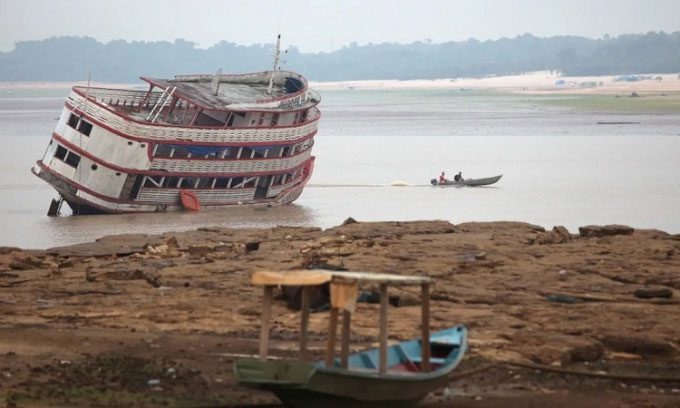The water level of the river flowing through the Amazon rainforest dropped to its lowest point in over a century on October 16 due to drought, affecting hundreds of thousands of people and disrupting the ecosystem.

Boat stranded on the Rio Negro river, a tributary of the Amazon River. (Photo: Bruno Kelly/Reuters)
The port of Manaus, the most populous city in the region, located at the confluence of the Rio Negro and the Amazon River, recorded a water level of 13.59 meters on October 16, significantly lower than the 17.6 meters recorded a year ago. This is the lowest level since data collection began in 1902, surpassing the previous record low in 2010. The rapidly drying tributaries of the Amazon River are causing boats to become stranded, cutting off food and drinking water supplies for remote villages, while high water temperatures are suspected to have killed over 100 endangered river dolphins, according to CNN.
After several months without rain, Pedro Mendonca, a villager living in the rainforest, felt relieved when a staff member from a non-governmental organization (NGO) brought essential supplies to his riverside village near Manaus last weekend. “Our community has experienced three months without rain,” Mendonca, who lives in the village of Santa Helena do Ingles, west of Manaus, the capital of Amazonas state, shared. “The weather is much hotter than during previous droughts.”
Some areas of the Amazon have seen the least rainfall from July to September since 1980, according to Brazil’s disaster warning center, Cemaden. Brazil’s Ministry of Science attributes this to the El Niño climate phenomenon that began this year, driving extreme weather patterns globally. In an announcement in early October, they predicted that the drought would last at least until December, when the effects of El Niño peak.
Behind El Niño is the long-term trend of global warming, leading to increasingly frequent and severe extreme weather events such as droughts and heatwaves. As of October 16, the drought has affected 481,000 people, according to the Amazonas state civil defense agency.
The drought threatens access to food, drinking water, and medicine, which are typically transported via river to the villages. Nelson Mendonca, the chief of Santa Helena do Ingles, noted that some areas can still be accessed by canoe, but many supply boats cannot navigate the river, so most goods arrive by tractor or on foot.



















































